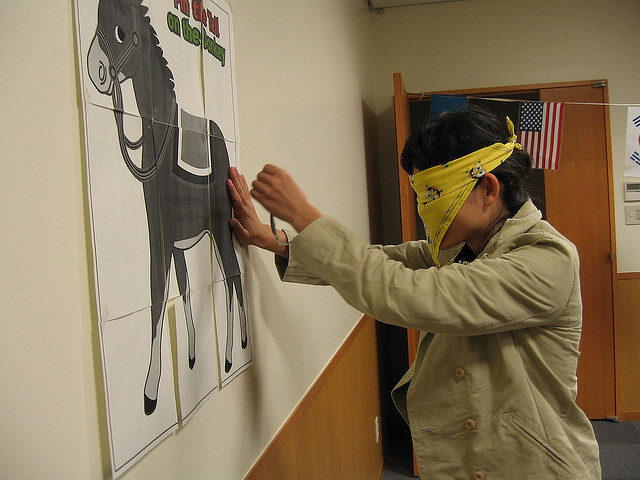Marketing’s Holy Grail – Emerging Customer Needs
 The Holy Grail of marketing is to identify emerging customer needs before anyone else and satisfy them to create new markets. It has been a long and fruitless slog as emerging needs have proven themselves elusive. And once candidates are identified, it’s a challenge to agree which are the game-changers and which are the ghosts. There are too many opinions and too few facts. But there’s treasure at the end of the rainbow and the quest continues.
The Holy Grail of marketing is to identify emerging customer needs before anyone else and satisfy them to create new markets. It has been a long and fruitless slog as emerging needs have proven themselves elusive. And once candidates are identified, it’s a challenge to agree which are the game-changers and which are the ghosts. There are too many opinions and too few facts. But there’s treasure at the end of the rainbow and the quest continues.
Emerging things are just coming to be, just starting, so they appy to just a small subset of customers; and emerging things are new and different, so they’re unfamiliar. Unfamiliar plus small same size equals elusive.
I don’t believe in emerging customer needs, I believe in emergent customer behavior.
Emergent behavior is based on actions taken (past tense) and is objectively verifiable. Yes or no, did the customer use the product in a new way? Yes or no, did the customer make the product do something it wasn’t supposed to? Did they use it in a new industry? Did they modify the product on their own? Did they combine it with something altogether unrelated? No argument.
When you ask a customer how to improve your product, their answers aren’t all that important to them. But when a customer takes initiative and action, when they do something new and different with your product, it’s important to them. And even when just a few rouge customers take similar action, it’s worth understanding why they did it – there’s a good chance there’s treasure at the end of that rainbow.
With traditional VOC methods, it has been cost prohibitive to visit enough customers to learn about a handful at the fringes doing the same crazy new thing with your product. Also, with traditional VOCs, these “outliers” are thrown out because they’re, well, they’re outliers. But emergent behavior comes from these very outliers. New information streams and new ways to visualize them are needed to meet these challenges.
For these new information streams, think VOC without the travel; VOC without leading the witness; VOC where the cost of capturing their stories is so low there are so many stories captured that it’s possible to collect a handful of outliers doing what could be the seed for the next new market.
To reduce the cost of acquisition, stories are entered using an app on a smart phone; to let emergent themes emerge, customers code their own stories with a common, non-biasing set of attributes; and to see patterns and outliers, the coded stories are displayed visually.
In the past, the mechanisms to collect and process these information streams did not exist. But they do now.
I hope you haven’t given up on the possibility of understanding what your customers will want in the near future, because it’s now possible.
I urge you to check out SenseMaker.
What Do You Believe About Independence?
 Independence is important; independence is powerful; it’s dangerous; it’s threatening. But, above all, independence is about control.
Independence is important; independence is powerful; it’s dangerous; it’s threatening. But, above all, independence is about control.
If you believe it’s a zero-sum-game, independence is adverserial – more for you, less for me. It’s give-and-take without the give – I don’t give you control, and you take it anyway.
If you believe there’s no trust, independence is scary. If you take initiative and demonstrate independence, you’re afraid I’ll repond negatively because you took control.
If you believe there’s no mutual respect, independence is spiteful. You give less control than you could and manipulate to take even less; I take more than the situation calls and politic to secure even more.
If you believe there’s a surplus, independence is empowering – more for you, more for me, more for everyone.
If you believe there’s trust, independence is exilerating. When you take initiative I tell the world you deserve all that control, and more.
If you believe there’s mutual respect, independence is nurturing. I push you to take more control, and you challenge yourself to do just that.
What do you believe?
Do The Work No One Is Asking For
 We spend too much time on the mundane. Every day people come to work, turn on their PCs, and the mundane magically happens on its own accord. Email gets sent, phones get answered, mail gets delivered, and processes get followed. And after lunch, the hamster wheel spins back up and the mundane consumes the rest of our day. Yet there’s no need because that stuff runs on its own. It’s time to leave it alone and manage the mundane by exception. If there’s a hiccup, give it a drink of water, and otherwise leave it alone. It’s time to recognize the massive opportunity cost of the mundane – mundane comes at the expense of meaningful.
We spend too much time on the mundane. Every day people come to work, turn on their PCs, and the mundane magically happens on its own accord. Email gets sent, phones get answered, mail gets delivered, and processes get followed. And after lunch, the hamster wheel spins back up and the mundane consumes the rest of our day. Yet there’s no need because that stuff runs on its own. It’s time to leave it alone and manage the mundane by exception. If there’s a hiccup, give it a drink of water, and otherwise leave it alone. It’s time to recognize the massive opportunity cost of the mundane – mundane comes at the expense of meaningful.
But when the mundane withers and there’s finally time for meaningful, there’s another chasm to cross – no one asks for meaningful work. Because meaningful work makes a difference and making a difference threatens the legacy of success, no one asks you for it. Because it’s considered impossible, there’s no request to do it. And because it’s considered a strength of your business, no one suggests you dismantle it. Crazy, but it’s time to stop the mundane so you can start doing work no one is asking you to do.
But it’s not any old work no one is asking for, it’s a special flavor, a flavor that meets a tight set of criteria.
Don’t do it unless it will make a difference. But not any old difference, a difference of epic proportions. If you explain the concept to the customer and they want to buy ten, you’re on the right track. If after you show the prototype the customer won’t give it back to you with a wrestling match, that’s the right work. If you present the concept to the core business unit and they immediately try to scuttle it, you’re on to something.
Don’t do it unless it resonates with you, personally. As subject matter expert, it must make your hair stand on end. As the inventor who must swim against the tide of “you can’t do that”, it must fill your deep need to help others. As the pariah who threatens the success of the company, it must be more than an idea – it must be part of you.
Leaders – it’s time to ask your people to work on things that are meaningful to them. Give them four hours a week and ask for an informal fifteen minute presentation every other week. They’ll make extreme progress and amaze you. Magically, because they’ll be so charged up, there will be time for all the work. Morale will skyrocket, the best folks will ask to work on your team, and you’ll have working prototypes for all the things you should have asked for.
Occam’s Razor For Innovation
 There are many flavors of innovation – incremental, disruptive, and seven flavors in between. And there is lots of argument about the level of innovation – mine’s radical and yours isn’t; that’s just improving what we already have; that’s too new – no one will ever buy it. We want to label the work in order to put it in the right bucket, to judge if we’re doing the right work. But the labels get in the way – they’re loaded with judgments, both purrs and snarls.
There are many flavors of innovation – incremental, disruptive, and seven flavors in between. And there is lots of argument about the level of innovation – mine’s radical and yours isn’t; that’s just improving what we already have; that’s too new – no one will ever buy it. We want to label the work in order to put it in the right bucket, to judge if we’re doing the right work. But the labels get in the way – they’re loaded with judgments, both purrs and snarls.
Truth is, innovation work falls on a continuum of newness and grouping them makes little sense. And, it’s not just newness that matters – it’s how the newness fits (or doesn’t) within the context of how things happen today and how customers think they should happen tomorrow. So what to do?
Customers notice the most meaningful innovations, and they notice the most meaningful ones before the less meaningful. Evaluate the time it takes a customer to notice the innovation and there may be hope to evaluate the importance of the innovation.
The technology reduces cost, and at the end of the month when the numbers are rolled up the accountants can see the improvement. This is real improvement, but there’s a significant lag and the people doing the work don’t see it as meaningful. This one’s a tough sell – buy this new thing, train on it, use it for three months, and if you keep good records and do some nifty statistics you’ll see an improvement.
The technology reduces scrap, and at the end of the week the scrap bin will be half full instead of fully full. Scrap is waste and waste reduction is real improvement. This is an easier sell – buy it and train on it and at the end of the week you’ll notice a reduction in scrap. This is important but only to those who are measured on scrap. And today the scrap is emptied every week, now we can empty it every other week. The time to notice is reduced, but the impact may not be there.
The technology increases throughput, and at the end of the shift the bins will be fuller than full. Here – try it for a shift and see what you think. If you like it, you can buy it. I’ll be back tomorrow with a quote. This is noticeable within eight hours. And at the end of eight hours there are more things that can be sold. That’s real money, and real money gets noticed.
The technology makes the product last two hours instead of one. Here – try it for a couple hours. I’ll go get a coffee and come back and see what you think. You won’t have to stop the machine nearly as often and you’ll put more parts into finished goods inventory. The technology gets noticed within two hours and the purchase order is signed in three.
Where the old technology was load, this is quiet. Don’t bother with ear protection, just give it a go. Pretty cool, isn’t it. Go get your boss and I’ll sell you a couple units right now. This one shows its benefits the end user right away – first try.
The most meaningful innovations get noticed instantly. Stop trying to label the innovation and simply measure how long it takes your customer to notice.
Experiment With Your People Systems
 It’s pretty clear that innovation is the way to go. There’s endless creation of new technologies, new materials, and new processes so innovation can create new things to sell. And there are multiple toolsets and philosophies to get it done, but it’s difficult.
It’s pretty clear that innovation is the way to go. There’s endless creation of new technologies, new materials, and new processes so innovation can create new things to sell. And there are multiple toolsets and philosophies to get it done, but it’s difficult.
When doing new there’s no experience, no predictions, no certainty. But innovation is no dummy and has come up with a way to overcome the uncertainty. It builds knowledge of systems through testing – build it, test it, measure it, fix it. Not easy, but doable. And what makes it all possible is the repeatable response of things like steel, motors, pumps, software, hard drives. Push on them repeatably and their response is repeatable; stress them in a predictable way and their response is predictable; break them in a controlled way and the failure mode can be exercised.
Once there’s a coherent hypothesis that has the potential to make magic, innovation builds it in the lab, creates a measurement system to evaluate goodness, and tests it. After the good idea, innovation is about converting the idea into a hypothesis – a prediction of what will happen and why – and testing them early and often. And once they work every-day-all-day and make into production, the factory measures them relentlessly to make sure the goodness is shipped with every unit, and the data is religiously plotted with control charts.
The next evolution of innovation will come from systematically improving people systems. There are some roadblocks but they can be overcome. In reality, they already have been overcome it’s just that no one realizes it.
People systems are more difficult because their responses are not repeatable – where steel bends repeatably for a given stress, people do not. Give a last minute deliverable to someone in a good mood, and the work gets done; give that same deliverable to the same person on a bad day, and you get a lot of yelling. And because bad moods beget bad moods, people modify each other’s behavior. And when that non-repeatable, one-person-modifying-another response scales up to the team level, business unit, company, and supply chain, you have a complex adaptive system – a system that cannot be predicted. But just as innovation of airliners and automobiles uses testing to build knowledge out of uncertainty, testing can do the same for people systems.
To start, assumptions about how people systems would respond to new input must be hardened into formal hypotheses. And for the killer hypotheses that hang together, an experiment is defined; a small target population is identified; a measurement system created; a baseline measurement is taken; and the experiment is run. Data is then collected, statistical analyses are made, and it’s clear if the hypothesis is validated or not. If validated, the solution is rolled out and the people system is improved. And in a control chart sense, the measurement system is transferred to the whole system and is left to run continuously to make sure the goodness doesn’t go away. If it’s invalidated, another hypothesis is generated and the process is repeated. (It’s actually better to test multiple hypotheses in parallel.)
In the past, this approach was impossible because the measurement system did not exist. What was needed was a simple, mobile data acquisition system for “people data”, a method to automatically index the data, and a method to quickly process and display the results. The experimental methods were clear, but there was no response for the experiments. Now there is.
People systems are governed by what people think and feel, and the stories they tell are the surrogates for their thoughts and feelings. When an experiment is conducted on a people system, the stories are the “people data” that is collected, quantified, and analyzed. The stories are the response to the experiment.
It is now possible to run an experiment where a sample population uses a smart phone and an app to collect stories (text, voice, pictures), index them, and automatically send them to a server where some software groups the stories and displays them in a way to see patterns (groups of commonly indexed stories). All this is done in real time. And, by clicking on a data point, the program brings up the story associated with that data point.
Here’s how it works. The app is loaded, people tell their stories on their phone, and a baseline is established (a baseline story pattern). Inputs or constraints are changed for the target population and new stories are collected. If the patterns change in a desirable way (statistical analysis is possible), the new inputs and constraints are rolled out. If the stories change in an undesirable way, the target population reverts back to standard conditions and the next hypothesis is tested.
Unbiased, real time, continuous information streams to make sense of your people systems is now possible. Real time, direct connection to your employees and your customers is a reality, and the implications are staggering.
Thank you Dave Snowden.
Put Yourself Out There
 Put yourself out there. Let it hang out. Give it a try. Just do it. The reality is few do it, and fewer do it often. But why?
Put yourself out there. Let it hang out. Give it a try. Just do it. The reality is few do it, and fewer do it often. But why?
In a word, fear. But it cuts much deeper than a word. Here’s a top down progression:
What will they think of your idea? If you summon the courage to say it out loud, your fear is they won’t like it, or they’ll think it’s stupid. But it goes deeper.
What with they think of you? If they think your idea is stupid, your fear is they’ll think you’re stupid. But so what?
How will it conflict with what you think of you? If they think you’re stupid, your fear is it will conflict with what you think of you. Now we’re on to it – full circle.
What do you think of you? It all comes down to your self-image – what you think is it and how you think it will stand up against the outside forces trying to pull it apart. The key is “what you think” and “how you think”. Like all cases, perception is reality; and when it comes to judging ourselves, we judge far too harshly. Our severe self-criticism deflates us far below the waterline of reality, and we see ourselves far shallower than our actions decree.
You’re stronger and more capable than you let yourself think. But no words can help with that; for that, only action will do. Summon the courage to act and take action. Just do it. And to calm yourself before you jump, hold onto this one fact – others’ criticism has never killed anyone. Stung, yes. Killed, no. Plain and simple, you won’t die if you put yourself out there. And even the worst bee stings subside with a little ice.
I’m not sure why we’re so willing to abdicate responsibility for what we think of ourselves, but we do. So where you may have abdicated responsibility in the past, in the now it’s time to take responsibility. It’s time to take responsibility and act on your own behalf.
Fear is real, and you should acknowledge it. But also acknowledge you give fear its power. Feel the fear, be afraid. But don’t succumb to the power you give it.
Put yourself out there. Do it tomorrow. You won’t die. And I bet you’ll surprise others.
But I’m sure you’ll surprise yourself more.
The Complexity Conundrum
 In school the problems you were given weren’t really problems at all. In school you opened the book to a specific page and there, right before you in paragraph form and numbered consecutively, was a neat row of “problems”. They were fully-defined, with known inputs, a formal equation that defined the system’s response, and one right answer. Nothing extra, nothing missing, nothing contradictory. Today’s problems are nothing like that.
In school the problems you were given weren’t really problems at all. In school you opened the book to a specific page and there, right before you in paragraph form and numbered consecutively, was a neat row of “problems”. They were fully-defined, with known inputs, a formal equation that defined the system’s response, and one right answer. Nothing extra, nothing missing, nothing contradictory. Today’s problems are nothing like that.
Today’s problems don’t have a closed form solution; today’s problems don’t have a right answer. Three important factors come into play: companies and their systems are complex; the work, at some level, is always new; and people are always part of the equation.
It’s not that companies have a lot of moving parts (that makes them complicated); it’s that the parts can respond differently in different situations, can change over time (learn), and the parts can interact and change each others’ response (that’s complex). When you’re doing work you did last time, there’s a pretty good chance the system will perform like it did last time. But it’s a different story when the inputs are different, when the work is new.
When the work is new, there’s no precedent. The inputs are new and the response is newer. Perturb the system in a new way and you’re not sure how it will respond. New interactions between preciously unreactive parts make for exciting times. The seemingly unconnected parts ping each other through the ether, stiffen or slacken, and do their thing in a whole new way. Repeatability is out the window, and causal predictability is out of the question. New inputs (new work) slathers on layers of unknownness that must be handled differently.
Now for the real complexity culprit – people. Companies are nothing more than people systems in the shape of a company. And the work, well, that’s done by people. And people are well known to be complex. In a bad mood, we respond one way; confident and secure we respond in another. And people have memory. If something bad happened last time, next time we respond differently. And interactions among people are super complex – group think, seniority, trust, and social media.
Our problems swim with us in a hierarchical sea of complexity. That’s just how it is. Keep that in mind next time you put together your Gantt chart and next time you’re asked to guarantee the outcome of an innovation project.
Complexity is real, and there are real ways to handle it. But that’s for another time. Until then, I suggest you bone up on Dave Snowden’s work. When it comes to complexity, he’s the real deal.
Image credit – miguelb.
The Illusion of Planning
Planning is important work, but it’s non-value added work. Short and sweet – planning is waste.
Lean has taught us waste should be reduced, and the best way to reduce waste from planning is to spend less time planning. (I feel silly writing that.) Lean has taught us to reduce batch size, and the best way to reduce massive batch size of the annual planning marathon is to break it into smaller sessions. (I feel silly writing that too.)
Unreasonable time constraints increase creativity. To create next year’s plan, allocate just one for the whole thing. (Use a countdown timer.) And, because batch size must be reduced, repeat the process monthly. Twelve hours of the most productive planning ever, and countless planning hours converted into value added work.
Defining the future state and closing the gap is not the way to go. The way to go is to define the current state (where you are today) and define how to move forward. Use these two simple rules to guide you:
- Do more of what worked.
- Do less of what didn’t.
Here’s an example process:
The constraint – no new hires. (It’s most likely the case, so start there.)
Make a list of all the projects you’re working on. Decide which to stop right now (the STOP projects) and which you’ll finish by the end of the month (the COMPLETED projects). The remaining projects are the CONTINUE projects, and, since they’re aptly named, you should continue them next month. Then, count the number of STOP and COMPLETED projects – that’s the number of START projects you can start next month.
If the sum of STOP and COMPLETED is zero, ask if you can hire anyone this month. If the answer is no, see you next month.
If the sum is one, figure out what worked well, figure out how to build on it, and define the START project. Resources for the START project should be the same as the STOP or COMPLETED project.
If the sum is two, repeat.
Now ask if you can hire anyone this month. If the answer is no, you’re done. If the answer is yes, define how many you can hire.
With your number in hand, and building on what worked well, figure out the right START project. Resources must be limited by the number of new hires, and the project can’t start until the new hire is hired. (I feel silly writing that, but it must be written.) Or, if a START project can’t be started, use the new resource to pile on to an important CONTINUE project.
You’re done for the month, so send your updated plan to your boss and get back to work.
Next month, repeat.
The process will evolve nicely since you’ll refine it twelve times per year.
Ultimately, planning comes down to using your judgment to choose the next project based on the resources you’re given. The annual planning process is truly that simple, it’s just doesn’t look that way because it’s spread over so many months. So, if the company tells its leaders how many resources they have, and trusts them to use good judgment, yearly planning can be accomplished in twelve hours per year (literally). And since the plan is updated monthly, there’s no opportunity for emergency re-planning, and it will always be in line with reality.
Less waste and improved quality – isn’t that what lean taught us?
A Viral Infection Of Alignment And Consensus
 Alignment is all the rage. The thinking goes: If we’re all pulling in the same direction, we’ll get their faster. There’s truth to that – the boat does go faster with more oars and more backs pulling on them. And as long as the boat’s heading in the right direction, alignment holds water. But here’s the dark side – while we’re all pulling on our own oar, we’re all sitting in the same boat. And when the boat is scuttled by a fast moving storm, we all go down together – in alignment.
Alignment is all the rage. The thinking goes: If we’re all pulling in the same direction, we’ll get their faster. There’s truth to that – the boat does go faster with more oars and more backs pulling on them. And as long as the boat’s heading in the right direction, alignment holds water. But here’s the dark side – while we’re all pulling on our own oar, we’re all sitting in the same boat. And when the boat is scuttled by a fast moving storm, we all go down together – in alignment.
Alignment, overdone, is not resilient. One longboat lost at sea doesn’t spell the end of for the clan, unless there’s only one boat. With the remaining boats, the Jarl can continue with trading neighboring clans while the shipwrights turn oaks into a beautiful replacement. Certainly a setback, but the Vikings survived. But more than survival, it’s also an opportunity for the shipwrights to try a new technology and make the new longboat faster than the old one.
Consensus isn’t the same as alignment, it but it too is in fashion and it too has a dark underbelly. Yes, it creates convergence on a go-forward plan, and, yes, everyone knows the plan and is good with it. But consensus dulls to the lowest common denominator and creates middle-of-the-of-the-road plans devoid of edge, sizzle, and excitement. Consensus reduces diversity of thinking, and, therefore, reduces resilience.
Consensus, unbridled, reduces thinking to a single strain which can be completely wiped out by an unforeseen antibiotic of change. But with consensus in check, many strains of thinking swim about the organization and no one environmental factor can wipe them out. When protected from consensus, diversity of thinking spawns parallel competing mindsets which improve corporate survivability.
Businesses are too complex to predict all possible bacterial and viral attacks. And even if you could, there are just too many too many of them. It’s far too costly for an organization to be robust to all possibilities.
It’s time to acknowledge knowable threats will find you at unpredictable times. And it’s time to evolve into a resilient organization.
How Things Really Happen
From the outside it’s unclear how things happen; but from the inside it’s clear as day. No, it’s not your bulletproof processes; it’s not your top down strategy; and it’s not your operating plans. It’s your people.
At some level everything happens like this:
An idea comes to you that makes little sense, so you drop it. But it comes again, and then again. It visits regularly over the months and each time reveals a bit of its true self. But still, it’s incomplete. So you walk around with it and it eats at you; like a parasite, it gets stronger at your expense. Then, it matures and grows its voice – and it talks to you. It talks all the time; it won’t let you sleep; it pollutes you; it gets in the way; it colors you; and finally you become the human embodiment of the idea.
And then it tips you. With one last push, it creates enough discomfort to roll over the fear of acknowledging its existence, and you set up the meeting.
You call the band and let them know it’s time again to tour. You’ve been through it before and you all know deal. You know your instruments and you know how to harmonize. You know what they can do (because they’ve done it before) and you trust them. You sing them the song of your idea and they listen. Then you ask them to improvise and sing it back, and you listen. The mutual listening moves the idea forward, and you agree to take a run at it.
You ask how it should go. The lead vocalist tells you how it should be sung; the lead guitar works out the fingering; the drummer beats out the rhythm; and the keyboardist grins and says this will be fun. You all know the sheet music and you head back to your silos to make it happen.
In record time, the work gets done and you get back together to review the results. As a group you decide if the track is good enough play in public. If it is, you set up the meeting with a broader audience to let them hear your new music. If it’s not, you head back to the recording studio to amplify what worked and dampen what didn’t. You keep re-recording until your symphony is ready for the critics.
Things happen because artists who want to make a difference band together and make a difference. With no complicated Gantt chart, no master plan, no request for approval, and no additional resources, they make beautiful music where there had been none. As if from thin air, they create something from nothing. But it’s not from thin air; it’s from passion, dedication, trust, and mutual respect.
The business books over-complicate it. Things happen because people make them happen – it’s that simple.
The Ladder Of Your Own Making
 There’s a natural hierarchy to work. Your job, if you choose to accept it is to climb the ladder of hierarchy rung-by-rung. Here’s how to go about it:
There’s a natural hierarchy to work. Your job, if you choose to accept it is to climb the ladder of hierarchy rung-by-rung. Here’s how to go about it:
Level 1. Work you can say no to – Say no to it. Say no effectively as you can, but say it. Saying no to level 1 work frees you up for the higher levels.
Level 2. Work you can get someone else to do – Get someone else to do it. Give the work to someone who considers the work a good reach, or a growth opportunity. This isn’t about shirking responsibility, it’s about growing young talent. Maybe you can spend a little time mentoring and the freed up time doing higher level work. Make sure you give away the credit so next time others will ask you for the opportunity to do this type of work for you.
Level 3. Work you’ve done before, but can’t wiggle out of – Do it with flair, style, and efficiency; do it differently than last time, then run away before someone asks you to do it again. Or, do it badly so next time they ask someone else to do it. Depending on the circumstance, either way can work.
Level 4. Work you haven’t done before, but can’t wiggle out of – Come up with a new recipe for this type of work, and do it so well it’s unassailable. This time your contribution is the recipe; next time your contribution is to teach it to someone else. (See level 2.)
Level 5. Work that scares others – Figure out why it scares them; break it into small bites; and take the smallest first bite (so others can’t see the failure). If it works, take a bigger bite; if it doesn’t, take a different smallest bite. Repeat, as needed. Next time, since you’ve done it before, treat it like level 3 work. Better still, treat it like level 2.
Level 6. Work that scares you – Figure out why it scares you, then follow the steps for level 5.
Level 7. Work no one knows to ask you to do – You know your subject matter better than anyone, so figure out the right work and give it a try. This flavor is difficult because it comes at the expense of work you’re already signed up to do and no one is asking you to do it. But you should have the time because you followed the guidance in the previous levels.
Level 8. Work that obsoletes the very thing that made your company successful – This is rarified air – no place for the novice. Ultimately, someone will do this work, and it might as well be you. At least you’ll be able to manage the disruption on your own terms.
In the end, your task, if you choose to accept it, is to migrate toward the work that obsoletes yourself. For only then can you start back at level 1 on the ladder of your own making.


 Mike Shipulski
Mike Shipulski